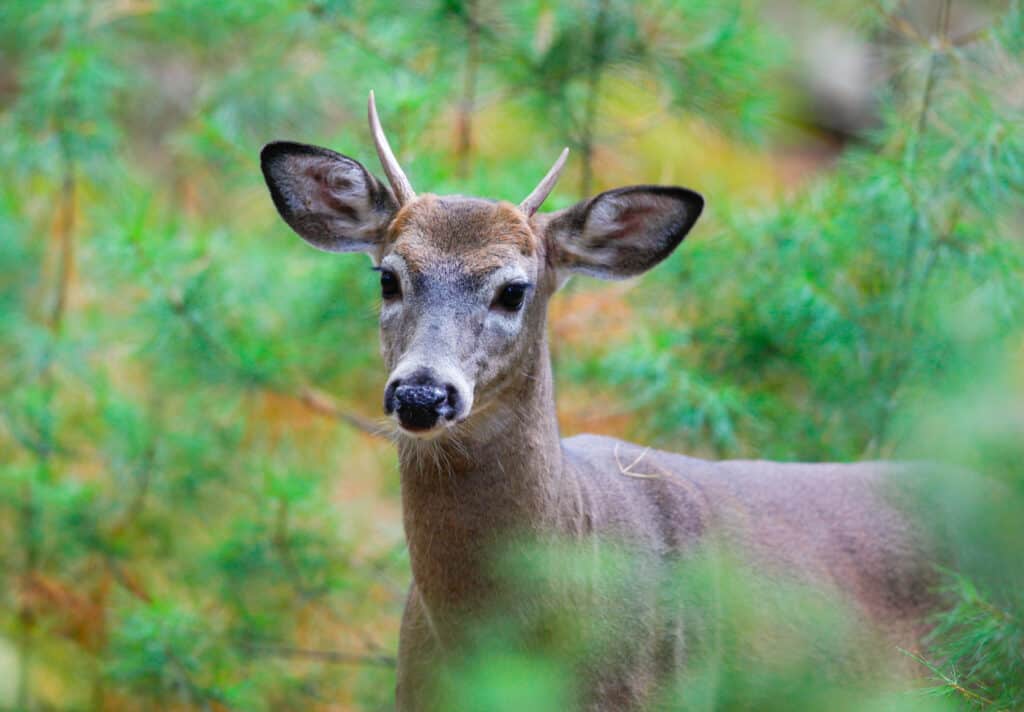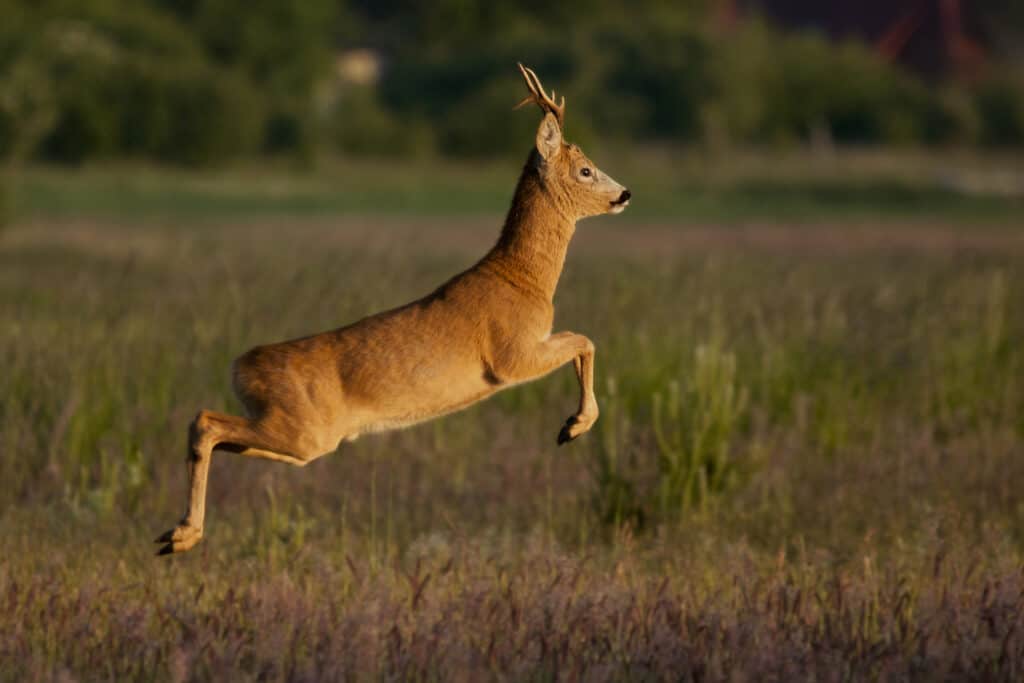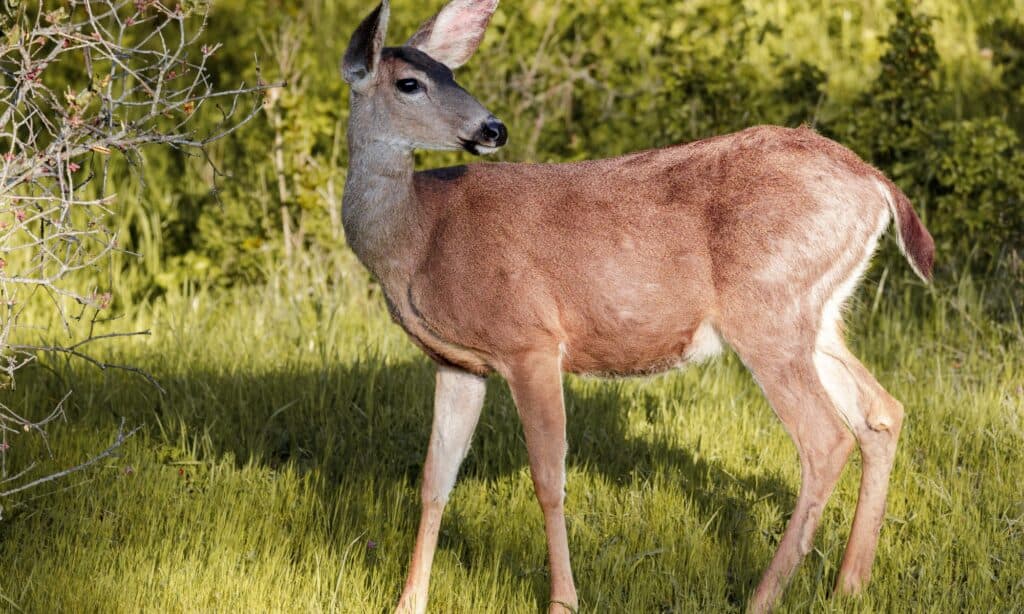In Oklahoma, deer season is open in the fall and winter, from October 1st until mid-January. The Oklahoma Department of Wildlife Conservation (ODWC) manages the deer population in the state. This is mainly done by setting the hunting seasons and deer hunting regulations and also by adjusting the bag limits each year.
The state is divided into ten antlerless deer zones to set different bag limits on harvesting antlerless deer. In general, the seasons and bag limits for antlered deer are the same statewide, and the seasons and bag limits for antlerless deer vary by the antlerless deer zone. This article will discuss the deer seasons, required licenses, and the regulations for hunting deer in Oklahoma.
Hunting Licenses and Other Requirements

Hunters must have a license to hunt deer in Oklahoma.
©iStock.com/JMrocek
Anyone over the age of 16 that would like to hunt in Oklahoma is required to purchase an Oklahoma hunting license. Adult residents who live in the state and are over 18 must purchase a Resident Annual Hunting License or a Resident Combination Hunting/Fishing License.
Youth Residents ages 16 and 17 must purchase either a Resident Youth Hunting License or a Resident Youth Combination Hunting/Fishing License. Annual licenses are available along with licenses valid for five years and also for the Lifetime of the hunter.
Nonresident hunters who do not live in Oklahoma and would like to travel to the state to deer hunt are required to purchase an Oklahoma nonresident license. Nonresidents 14 years of age and older must purchase a Nonresident Annual Hunting License or a Nonresident 5-Day Hunting License. As the names imply, the Annual license is valid for one year while the 5-day license is valid for five days.
To hunt deer in Oklahoma, hunters must also purchase a specific deer license for the season they would like to hunt. For adult residents 18 and older, there are Resident Deer Archery, Resident Deer Muzzleloader (Antlered and Antlerless), and Resident Deer Gun (Antlered and Antlerless) licenses required for the season indicated.
A Resident Holiday Antlerless Deer Gun license is also available for the Holiday Antlerless season. Youth versions of these licenses are also required for hunters under 18. For non-residents, similar licenses are required. For nonresident adults, the nonresident version of the same licenses as residents are required. However, there are no separate antlered or antlerless licenses.
Nonresident Youth hunters’ licenses are similar to resident youth hunters, except there are either sex and antlerless versions of each license instead of antlered and antlerless versions.
Permit Requirements
Hunting in state Wildlife Management Areas may also require a Land Access Permit, of which there are resident and nonresident versions. Luckily, no other permits are necessary for hunting deer in this state.
Hunter Education Requirements
Anyone 30 years old or younger must provide a certificate of competency and safety in the use and handling of firearms from the wildlife department before purchasing a hunting license.
A hunter safety certificate issued by another state or country and approved by the Wildlife department meets this requirement. The course is available as an online course or an in-person classroom course.
Children under ten years old may take the hunter safety course. However, they are not eligible to be tested and receive a certificate.
An apprentice hunting license is available for hunters younger than 30 years old who have not completed a hunter education course and would like to try hunting. Anyone who has an apprentice hunting license must be accompanied by an adult 18 years of age or older that has a hunting license while deer hunting.
The accompanying adult must be within arm’s length of the apprentice hunter so they can take immediate control of the firearm or bow at any time.
Types of Deer Seasons in Oklahoma

In total, there are five deer season types in Oklahoma.
©iStock.com/Louise Wightman
Deer Hunting in Oklahoma offers three basic deer season types. However, there are technically five different seasons in total. Some share very similar regulations, in any case. Only certain hunting equipment can be used during many of these seasons.
There is a Youth season and a Holiday Antlerless season that follow the same rules as the Gun season. Youth Deer Gun season is held the second Fri-Sat-Sun weekend in October.
Archery season starts on October 1st and is open until January 15th. Deer Muzzleloader season is open the second to last weekend in October and closes on the last Sunday of October. Deer Gun season opens the Saturday before Thanksgiving and closes on the second Sunday after Thanksgiving.
The Holiday Antlerless Deer Gun season is open for the final two weeks of the year and closes on Dec 31st.
Season Type Regulations
The deer seasons have different regulations on the equipment and hunting methods that may be used. Bag limits also vary depending on the sex of the deer, season, and zone where the deer is harvested. The list below summarizes each with the legal weapons that can be used.
Archery Season
During this season, archery equipment can be used. Compound bows must have at least a 30-pound draw weight; other bows must have at least a 40-pound draw weight. Handheld releases and devices that allow a bow to be held mechanically at the full or partial draw are allowed.
Crossbows must have a draw weight of at least 100 pounds and be equipped with a working safety. Leverage-gaining devices are allowed. Arrows and/or bolts must be tipped with broadheads that are at least 7/8 of an inch wide. This includes mechanical broadheads in the open position.
Bolts used in crossbows must be at least 14 inches long. Thermal sights, laser sights, and light enhancement devices are not allowed. Firearms are not allowed to be possessed during the archery season unless the hunter has the proper licenses and a firearm season is open.
A total of six deer may be harvested during this season. However, no more than two of them may be antlered.
Muzzleloader Season
During muzzleloader season, muzzleloading rifles, shotguns, and pistols may be used. These firearms must be loaded from the muzzle end of the barrel. Muzzleloading rifles and pistols must be .40 caliber or larger and fire a single ball or bullet.
Muzzleloading shotguns must be 20 gauge or larger and fire a single slug. Archery equipment, as described above, that is legal during the archery season is also allowed. Any modern firearm or firearms loaded from the breech are not allowed to be used during this season.
A total of four deer may be harvested during this season. However, no more than one of them may be antlered. Antlerless harvest limits vary by zone during the muzzleloader season.
Gun Season
Firearms that fire modern cartridges, such as rifles, handguns, and shotguns, may be used during the firearm season. Archery equipment, muzzleloaders, and arrow rifles may also be used. Rifles must use centerfire cartridges with at least a 55-grain weight soft-nosed or hollow-point bullet.
There is no restriction on the magazine capacity of rifles. Handguns must use centerfire cartridges with a least a 55-grain bullet, fire a single bullet, and have a barrel that is at least four inches long. Shotguns can be any size and must fire centerfire cartridges with slug projectiles; buckshot is not allowed. Archery equipment and muzzleloaders can be used but must follow the same restrictions as above.
Arrow rifles fire an arrow or a bolt using compressed gas to propel them. These rifles must maintain a minimum pressure of 200 psi and have a visible pressure gauge to verify. Arrow and bolts must be at least 18 inches long, have fletching for stability, and be tipped with broadheads at least 7/8 of an inch wide.
Mechanical broadheads are allowed and must also be 7/8 of an in wide in the open position. Firearms may be fitted with suppressors that the owner legally possesses. Fully automatic firearms, laser sights, thermal tracking devices, and light-enhancing devices are not allowed.
A total of four deer may be harvested during this season. However, no more than one of them may be antlered. Note that some zones have different limits for antlerless deer.
Youth Deer Gun Season
Youth Deer Gun season is open to youth hunters ages 17 and younger. The same hunting devices may be used as described above in the gun season. All youth hunters must be accompanied by an adult 18 years of age or older.
Two deer may be harvested during this season. However, no more than one may be antlered. Harvesting antlerless mule deer is not allowed. This total applies toward the hunter’s six deer season limit but does not count toward the hunter’s gun season limit of four deer.
Holiday Antlerless Gun Season
All the hunting devices for the gun season are legal during the Holiday Antlerless Gun season. In general, two antlerless white-tail deer may be taken during this season and do not count towards the hunter’s season limit of six deer. Note that Zone 1 is closed for this season.
Regulations for All Seasons

Shooting a deer across the road or highway is prohibited.
©Tomasz Wrzesien/Shutterstock.com
While hunting in Oklahoma, hunters should keep several key rules and regulations in mind. This is a partial list of some of those rules and is not a fully inclusive list. All hunters should review all the regulations before hunting and how they might apply.
Hunting on private land that is posted or occupied requires permission from the landowner. Possessing a deer taken by someone else is not allowed unless the deer is tagged with the taker’s name, address, customer ID number, the date it was taken, and online confirmation number when it was checked in. Be sure to tag any deer you take correctly. Otherwise, you may be breaking the law.
Hunting from a motor-driven land, air, or water vehicle is prohibited. Shooting from or across any public road, highway, or railroad is prohibited. A loaded firearm may not be transported in a land or water-based vehicle.
No one may kill a deer and leave the carcass without reasonably attempting to retrieve it. Killing a deer, removing the antlers, and leaving the carcass is not allowed.
Shooting hours are one-half hour before official sunrise to one-half hour after official sunset. Using dogs to hunt deer is not allowed. A leashed dog is allowed to track a wounded deer after notifying a game warden.
It is not allowed to dump the carcass of any dead animal in a well, spring, pond, or stream or leave it within ¼ mile of any occupied dwelling or public highway without burying it appropriately.
While any firearm season is open, hunters must wear both a head covering and a garment above the waist that totals at least 400 square inches of hunter daylight fluorescent orange. Camouflage hunter orange is allowed as long as at least 400 square inches of orange are visible.
The combined season limit is six deer, with no more than two being antlered. An antlered deer is defined as any deer with at least three inches of antler visible above the hairline.
Being safe while hunting is important since deadly weapons are involved. Being careless can result in serious injury.
When handling a firearm, hunters should understand and follow the four basic rules of firearm safety:
- Treat every firearm as if it were loaded.
- Always keep the muzzle of a firearm pointed in a safe direction.
- Keep your finger off the trigger until you are ready to shoot.
- Be sure of your target and what is beyond it.
If you hunt with a bow and arrow, keep the broadheads safely covered until you are ready to shoot. Clearly identify your target deer and make sure it is antlered or antlerless, depending on your bag limit. Understand what is beyond your target deer, and ensure there is no other deer or an area where people may be.
If you miss your shot, you could mistakenly take a different deer or, even worse, injure someone.
Hunting deer from a tree stand is a popular choice, especially for bow hunters. More hunting injuries occur from falling while using a tree stand than any other accident. If you use a tree stand, be sure to understand how to climb and secure it safely at ground level before you go hunting for the first time.
Always use a full-body safety harness and a safety line while climbing. Most falls occur while hunters are climbing into or out of the stand. Do not attempt to carry anything while you are climbing. Climb above the stand and step down into it. Leave your equipment on the ground and pull it up using a haul line after you are safely in the stand.
Chronic Wasting Disease in Oklahoma

CWD has not been detected in Oklahoma.
©iStock.com/yhelfman
Chronic Wasting Disease (CWD) is a neurological disease that affects the brains of deer, elk, moose, and other members of the deer family (Cervidae). The disease causes holes in the deer’s brain that resembles those in sponges.
CWD always results in the deer dying early in its natural life, and there is no known treatment or vaccine. It has been found in the US, Canada, and the surrounding states of Texas, New Mexico, Colorado, Kansas, Missouri, and Arkansas. As of 2022, CWD has not been detected in Oklahoma.
In 2022, a deer was found positive for CWD 2.5 miles south of the Oklahoma border in Texas.
The ODWC immediately established a Selective Surveillance area (SSA) in the southern zone of the state. Any deer or elk harvested in the area must be processed before it can leave the area. These deer parts are the only items that are allowed to leave the SSA:
- Antlers detached from the skull plate or antlers attached to a clean skull plate
- Meat or quarters with all parts of the spinal column removed
- Cleaned teeth
- Finished taxidermy mounts
- Finished hides
These restrictions also apply to any deer harvested outside of the state in areas where CWD has been detected. Hunters are also encouraged to volunteer their harvested deer in the area for testing. More information on the SSA and testing can be found here.
While there is no documented evidence that CWD can affect humans, the CDC recommends that hunters do not consume meat from animals that appear sick or test positive for CWD.
Tagging and Reporting
After harvesting a deer, all hunters must immediately attach a field tag to the deer. The tag can be made from any item but must include the hunter’s name, customer ID number, date, and time of harvest. After the deer is tagged, it may be field dressed and moved.
Before processing the deer, it must be checked in within 24 hours of leaving the harvest area through the online E-check system at wildlifedepartment.com, on the Go Outdoors Oklahoma mobile app, or with an authorized Department employee.
Once the deer is checked, the hunter will be given a carcass tag or an online confirmation number. The tag with the confirmation number must remain with the carcass to its final destination or through processing and storage.
Potential Fines and Common Violations
Taking a deer illegally in Oklahoma could result in fines and several other penalties. Game wardens can also confiscate your hunting equipment on the spot if they suspect you are not hunting legally.
In 2019, a woman was fined $2,400 for shooting a deer outside of the gun season, shooting it at night with the aid of spotlights, and only harvesting the deer’s head and back-strap meat.
In 2022, a man purchased a hunting license after harvesting a deer and then tried to e-check the animal. He was given a citation for illegally hunting without a deer archery license and taking wildlife.
Trespassing is also a common violation on farms and agricultural areas that is a crime and punishable under the law. In addition to fines, lawyer fees and court costs can add up if your case goes to court.
As you can see, violating any wildlife laws in Oklahoma is a serious offense. Even though it may not seem to be important, it deserves attention. Before the season, all hunters should read and understand all the regulations.
Oklahoma is a popular state for nonresidents to hunt deer since the licenses are fairly low cost, and the bag limits are higher than most states. If you travel to the state to hunt, do not assume the rules are the same as your home state. Take the time to read all the regulations because not taking the law seriously could result in costly penalties.
Up Next
The photo featured at the top of this post is © Tomasz Wrzesien/Shutterstock.com
Sources
- Oklahoma Wildlife Department, Available here: https://www.wildlifedepartment.com/hunting/seasons
- Oklahoma Wildlife Department (1970) wildlifedepartment.com/hunting/regs
Thank you for reading! Have some feedback for us? Contact the AZ Animals editorial team.






